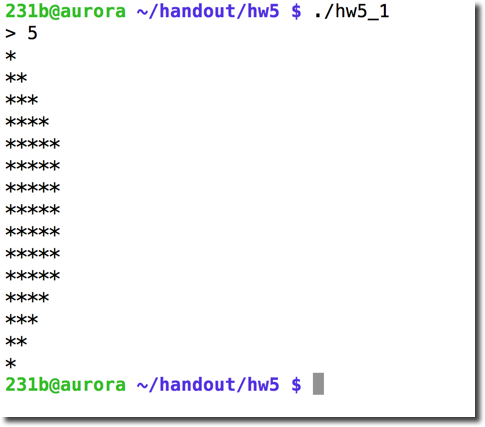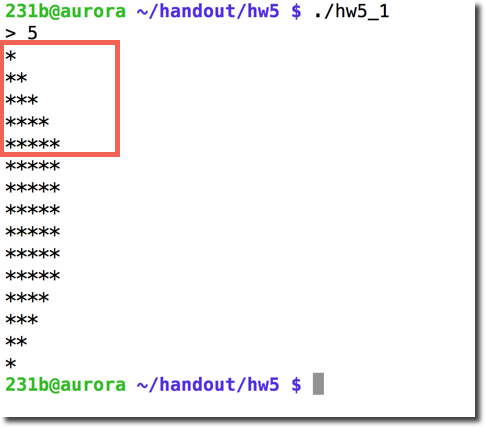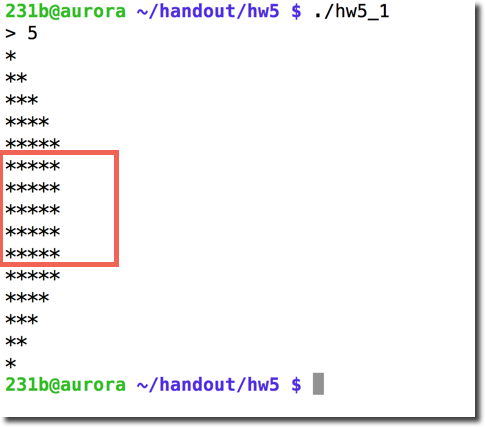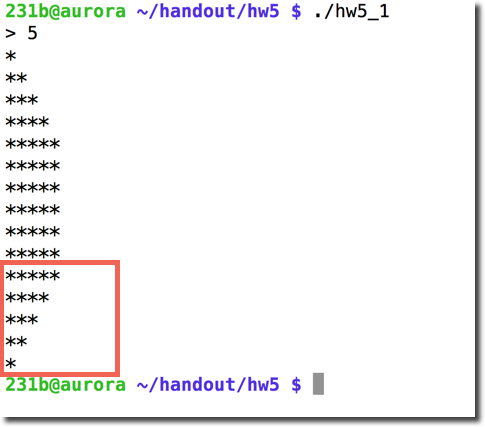Difference between revisions of "CSC231 Homework 5 2017"
(→Solution Executable) |
|||
| Line 90: | Line 90: | ||
Note that it is normal for the 6 that the user entered not to be found in the output. That's a side effect of redirecting the output of programs to files: the keyboard input is not captured. | Note that it is normal for the 6 that the user entered not to be found in the output. That's a side effect of redirecting the output of programs to files: the keyboard input is not captured. | ||
| + | <br /> | ||
| + | ==Hints== | ||
| + | <br /> | ||
| + | You will find out that you will need a for loop to control how many lines you need to print. The for-loop will require ecx to control the number of iterations. However, printing a string requires the use of ecx, so your ecx register will be modified inside the loop by the print section... So you need to save the ecx register somewhere before you print, and restore it after you've finished printing. You can use another register, or you can use a memory variable for storage... | ||
<br /> | <br /> | ||
==Submission== | ==Submission== | ||
Revision as of 07:38, 25 March 2017
--D. Thiebaut (talk) 08:12, 25 March 2017 (EDT)
This homework is due on 4/3/17, at 11:55 p.m.
Problem #1
Write an assembly language program called hw5_1.asm that prompts the user for an integer, and prints out a pattern of stars representing a triangle, a square, and another triangle.
Here is an example where the user enters 5 when prompted by the program:
Note that the output corresponds to 3 geometric patterns: a triangle of 5 lines, a square of 5 lines, and another triangle of 5 lines. The width of the square and triangles is 5 star (max length of a line).
Solution Executable
The executable version of the solution program is available for you to play with. Get a copy of it as follows:
getcopy hw5_1sol
and run it a few times to see how it works:
./hw5_1sol
You can compare the output of your program to the solution program by running these linux commands (we assume that we want to test the two programs with an input of 6):
231b@aurora hw5 $ cat > input.txt 6 ^D (type Control-D then ENTER to indicate end of input) 231b@aurora hw5 $ ./hw5_1 < input.txt > output.txt 231b@aurora hw5 $ ./hw5_1sol < input.txt > outputsol.txt 231b@aurora hw5 $ diff -y output.txt outputsol.txt > * > * ** ** *** *** **** **** ***** ***** ****** ****** ****** ****** ****** ****** ****** ****** ****** ****** ****** ****** ****** ****** ****** ****** ***** ***** **** **** *** *** ** ** * *
If your output does not match the solution output, you will see a special character
> * > * ** ** *** *** **** **** ***** ***** ****** ****** ****** ****** ****** ****** ****** ****** ****** ****** ****** ****** ****** ****** > ****** ***** ***** **** **** *** *** ** ** * *
In this case the solution output in on the right, and the blank line in your output indicates that your output is missing a line that is found in the solution output. You can then modify your program to make it work perfectly well.
Note that it is normal for the 6 that the user entered not to be found in the output. That's a side effect of redirecting the output of programs to files: the keyboard input is not captured.
Hints
You will find out that you will need a for loop to control how many lines you need to print. The for-loop will require ecx to control the number of iterations. However, printing a string requires the use of ecx, so your ecx register will be modified inside the loop by the print section... So you need to save the ecx register somewhere before you print, and restore it after you've finished printing. You can use another register, or you can use a memory variable for storage...
Submission
Submit your asm file (not the executable) to Moodle. You won't be able to run or evaluate it, so make sure your program works exactly as the solution program!!!



